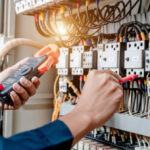Smart home automation setup transforms homes into intelligent spaces with seamless device integration and voice-controlled convenience.
With advanced technology, controlling home appliances remotely is now easier and enhances security, efficiency, and comfort.
Understanding Smart Home Automation
A Smart home automation Setup connects multiple devices, allowing centralized control using voice commands or mobile applications efficiently.
It includes smart lighting, security cameras, thermostats, and voice assistants for managing daily tasks effortlessly.
Essential Components of Smart Home Automation
A complete smart home setup includes hubs, smart switches, sensors, security devices, and high-speed internet connectivity.
Each component plays a crucial role in enhancing automation functionality, efficiency, and ensuring seamless device communication.
Choosing the Right Smart Hub
A smart hub acts as a central controller, connecting various devices for automation and efficient management.
Popular smart hubs include Amazon Echo, Google Nest Hub, and Samsung SmartThings for seamless integration of smart gadgets.
Smart Lighting Solutions for Homes
Smart bulbs and LED strips offer remote control, automation, dimming options, and color-changing features for ambiance.
They integrate with voice assistants, mobile apps, and sensors for personalized lighting experiences and energy efficiency.
Smart Security Systems for Safety
Installing smart locks, cameras, and motion sensors enhances home security, offering real-time monitoring and automated alerts.
These systems provide remote access, facial recognition, and AI-driven analysis to prevent unauthorized access efficiently.
Automated Climate Control for Comfort
Smart thermostats and air conditioning systems help maintain ideal temperatures and reduce energy consumption significantly.
They learn user preferences, adjust settings automatically, and provide remote control through mobile applications efficiently.
Voice Assistants for Seamless Integration
Voice assistants like Alexa, Google Assistant, and Siri enable hands-free control of smart home devices effortlessly.
They assist in setting reminders, playing music, controlling lights, and even ordering groceries conveniently.
Smart Entertainment Systems for Homes
Home theaters, streaming devices, and wireless speakers create immersive entertainment experiences with seamless integration.
Smart TVs, soundbars, and projectors support voice commands, personalized playlists, and advanced automation features.
Home Automation for Energy Efficiency
Smart plugs, power strips, and sensors help monitor energy usage, reducing electricity bills and environmental impact effectively.
They enable scheduling appliances, turning off unused devices, and providing real-time energy consumption insights efficiently.
Kitchen Automation for Convenience
Smart refrigerators, ovens, and coffee makers simplify kitchen tasks by offering remote control and automation features.
They provide notifications, recipe suggestions, and integration with grocery apps for streamlined kitchen management.
Smart Home Gardening Solutions
Automated watering systems, smart plant sensors, and weather-based controllers enhance gardening by optimizing water usage effectively.
These systems monitor soil conditions, sunlight exposure, and humidity levels for healthier plant growth effortlessly.
Connectivity and Compatibility Considerations
Ensure smart devices are compatible with Wi-Fi, Zigbee, Z-Wave, or Bluetooth for seamless integration and connectivity.
Choosing compatible devices prevents connectivity issues, ensuring smooth communication between different automation components efficiently.
Privacy and Security Measures
Implement strong passwords, encryption, and two-factor authentication to protect smart home devices from cyber threats.
Regularly updating firmware, disabling unnecessary access, and using secure networks prevent unauthorized hacking attempts effectively.
Customizing Smart Home Automation
Creating personalized automation routines enhances convenience, ensuring devices operate based on schedules, location, and user preferences.
Smart home apps allow users to set automation scenes for waking up, sleeping, or returning home effortlessly.
Future Trends in Smart Home Technology
AI-driven automation, advanced IoT integration, and 5G connectivity will revolutionize smart home technology for better experiences.
Future homes will feature predictive automation, energy-efficient solutions, and deeper integration with everyday activities seamlessly.
Conclusion
A smart home automation setup enhances comfort, security, and efficiency, making daily routines more convenient and stress-free.
By integrating smart devices strategically, homeowners can create intelligent living spaces tailored to their unique preferences efficiently.

